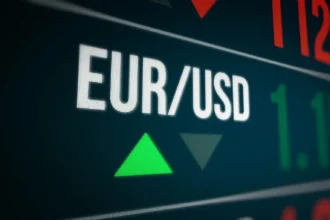Euro Continues Downtrend as ECB Signals Potential Rate Cuts
As of March 16, 2025, the EUR/USD currency pair remains under bearish pressure, weighed down by dovish comments from the European Central Bank (ECB) and renewed global trade tensions. The euro has now depreciated by more than 8% since its peak in September 2024, as investors remain cautious about the ECB’s monetary policy direction.
ECB Vice President Luis de Guindos recently hinted that eurozone inflation is stabilizing, strengthening the case for interest rate cuts in the coming months. The ECB’s decision to reduce rates four times in 2024, bringing them down to 3.15%, has fueled expectations of further easing, especially with inflation currently at 2.4%, near the ECB’s 2% target.
US-Canada Trade Dispute Adds Pressure on Global Markets
Adding to the euro’s weakness, market volatility has intensified due to heightened trade tensions between the United States and Canada. President Donald Trump recently doubled tariffs on Canadian steel and aluminum imports, raising them to 50% in response to Ontario’s new electricity surcharge on U.S. states.
The ripple effect of this decision has already hit Wall Street, with major indexes like the S&P 500, Dow Jones, and Nasdaq experiencing losses of over 0.75%. Many analysts fear that these protectionist policies could push the U.S. economy closer to a recession, which has been dubbed the “Trumpcession.”
Technical Analysis: Key Support and Resistance Levels for EUR/USD
The EUR/USD pair remains locked in a strong downtrend, moving within a well-defined bearish channel since September 2024.
- Key Support Level: 1.0262 – A break below this level could trigger further selling pressure.
- Key Resistance Levels: 1.0397 and 1.0550 – These levels correspond to previous swing lows from November 2024 and could act as strong barriers for any potential recovery.
The Relative Strength Index (RSI) shows bullish divergence, hinting at a possible short-term retracement. However, unless the pair reclaims 1.0500, the overall trend remains bearish.
Interest Rate Differential and Capital Flow Impact on EUR/USD
Another critical factor affecting EUR/USD is the interest rate differential between the U.S. Federal Reserve and the ECB.
- U.S. interest rates: 4.5%
- European interest rates: 3.15%
With higher yields in the U.S., investors are favoring USD-denominated assets, contributing to sustained selling pressure on the euro.
EUR/USD Forecast: Will the Euro Recover or Decline Further?
For EUR/USD bulls, the pair must break above 1.0500 to signal a shift in momentum. However, if bearish sentiment prevails, we could see the pair test new lows below 1.0200 in the coming weeks.
Traders should closely monitor:
✔ Upcoming ECB statements for further rate cut indications.
✔ US trade policy developments, especially any new tariff decisions.
✔ Key technical levels, particularly 1.0262 (support) and 1.0500 (resistance).
The EUR/USD outlook remains uncertain, and traders should stay cautious as global economic risks continue to evolve.



